Low Bar Squat Wrist Pain: Reasons & Solutions
Author:
Reviewed by:
(21 years of Oly Lifting experience)
Unlock your full potential by engaging with our experts and community! Have questions about your fitness journey or looking for expert advice on weightlifting techniques? Don’t hesitate — leave a comment below and David Sasha Schulz will provide a personalized answer and insights to help you reach your goals.
Torokhtiy is reader-supported. Some links are affiliate links, and we may earn a commission at no extra cost to you. See our disclosure page for details.
In this article, I’m going to look at a common problem when squatting – low bar squat wrist pain. I’ll discuss why it happens and the different ways you can fix it so it won’t happen again.
Disclaimer
This article is meant to provide information on wrist pain and is not a replacement for a medical examination and/or treatment. If you feel pain, make sure to consult a doctor for professional medical advice.
Low bar squat wrist pain is a commonly reported problem among lifters, but it can be easily fixed if you approach it correctly.
A low bar squat has biomechanics as a high bar squat but the barbell is placed lower on the upper back. Instead of the top of the shoulders, the bar rests on the posterior deltoids.
Compared to a high bar squat, the low bar squat focuses more on the posterior chain, mainly the glutes, hamstrings and back extensors. While low bar squats require more mobility in the upper body, many lifters feel it increases their lifting performance, making them a popular choice.
In this article, I’ll take you through the possible causes and solutions of wrist pain to help get you lifting pain-free.
Common causes of low bar squat wrist pain include grip positioning, bar positioning, and wrist mobility. Changing your grip and bar position, wearing wrist wraps, and working on your wrist mobility are all possible solutions.
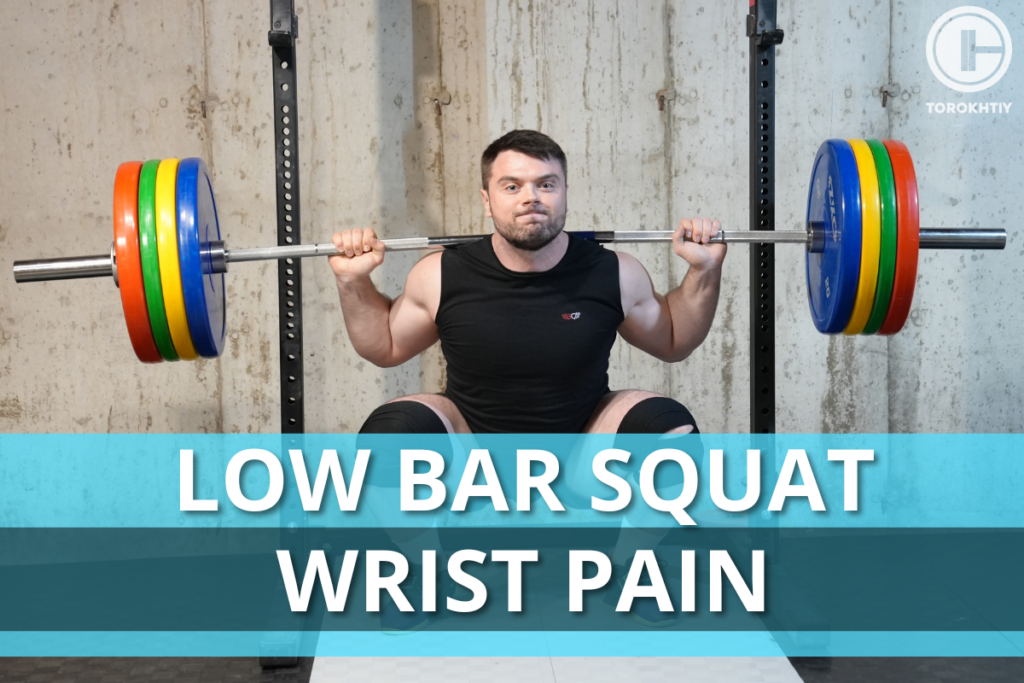
Why Does Your Wrist Hurt During Low Bar Squats?
Your hands and wrists are pretty complicated, meaning a lot is happening in such a small space. With complicated joint and tissue structures, wrist pain can be fairly common and caused by different things:
1. Your Grip is Too Wide
While this is pretty obvious to most people, it’s one of the more common causes of wrist pain from low bar squatting. With a bar grip that’s too wide, the angle created from your forearm and wrist position is too big.
This leads to pinching of the tissues around the wrist joint which then causes pain. With a grip that’s too wide, a common indicator is wrist pain near the thumb.
2. Your Grip Is Too Narrow
Another common cause of wrist pain is your hands being too close together on the barbell. With a grip position that’s too close, the angle between your wrist joint and forearm is too small.
This leads to the corresponding bones putting pressure on each other, with the wrist joints bending too far back and leading to wrist pain. With a grip that’s too narrow, wrist pain is commonly felt in the back of the hand.
3. The Barbell Is Too Low
While a low bar squat places the barbell on your posterior delts, letting the bar slip lower hugely increases the pressure on your wrists, with the joints bending backward far beyond the normal range of motion. This can also be a possible cause of wrist pain in the back of the hand.
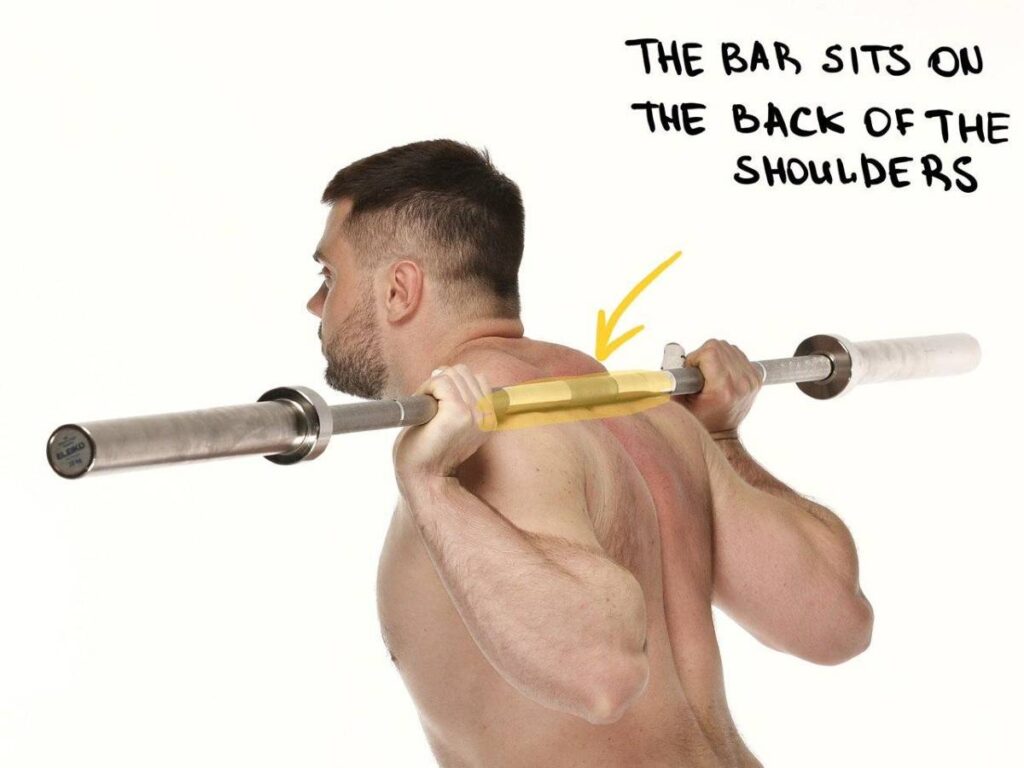
How to Fix Wrist Pain While Squatting?
To fix wrist pain while performing low bar squats, start by going through these solutions to find the underlying cause.
1. Work on Wrist Mobility
One of the most common causes of wrist pain during a low bar squat is a lack of wrist mobility. When self-assessing your wrist mobility, start by checking the available range of motion.
To check both the active and passive ranges of motion, perform wrist flexion, extension, ulnar deviation, and radial deviation.
If you feel more pain with active movement (using the muscles in your wrist) then the pain might be caused by muscles and tendons rather than joints.
Passive movement pain (using your other hand to move your wrist) indicates that the issue is your joints.
To work on your wrist mobility, perform soft tissue massages, stretch and do wrist mobility exercises.
2. Change Your Grip Width
Another common cause of wrist pain during a low bar squat can be your grip width. Grip width refers to how far your hands are apart when gripping the barbell.
As your grip becomes wider on the bar, your wrists tend to radially deviate more, meaning sideways bending towards the thumb. This increased radial deviation with a wider grip width tends to place more stress on the joints at the base of the thumb, causing wrist pain in that area.
Experiment with different grip widths and see if the wrist pain persists. Slowly narrow your grip while checking your wrist pain. On the other hnad, if your grip is very narrow, try to widen your grip slightly to maintain a more neutral position.
3. Use Wrist Wraps
Wrist wraps provide a simple and cost-effective way to alleviate common wrist pain by providing support to the wrist joints during high-pressure movements such as squats. Wrist wraps help to reduce wrist pain by preventing extreme ranges of motion and movements that can cause pain around the wrist joint.
Follow us!

Free!
Get a 2-week Weightlifting Program as a bonus for the subscription to kickstart your training plan!

Free!
The tightness of the wraps should depend on the amount of pain you’re experiencing, with the amount of compression supporting the joint but not feeling too painful.
WARM BODY COLD MIND Weight Lifting Wrist Wraps
The Warm Body Cold Mind (WBCM) Premium Cotton Weightlifting Wrist Wraps are an excellent option if you’re looking for a pair of durable, high-quality wraps. WBCM is well-known for producing premium products at lower price points.
Made from premium cotton that’s joined with reinforced stitching, the wraps are designed for repeated, heavy-duty use. With the elastic strap and anchor system, the wraps can be taken on and off within seconds using the thumb loop and wrap-around wrist support.
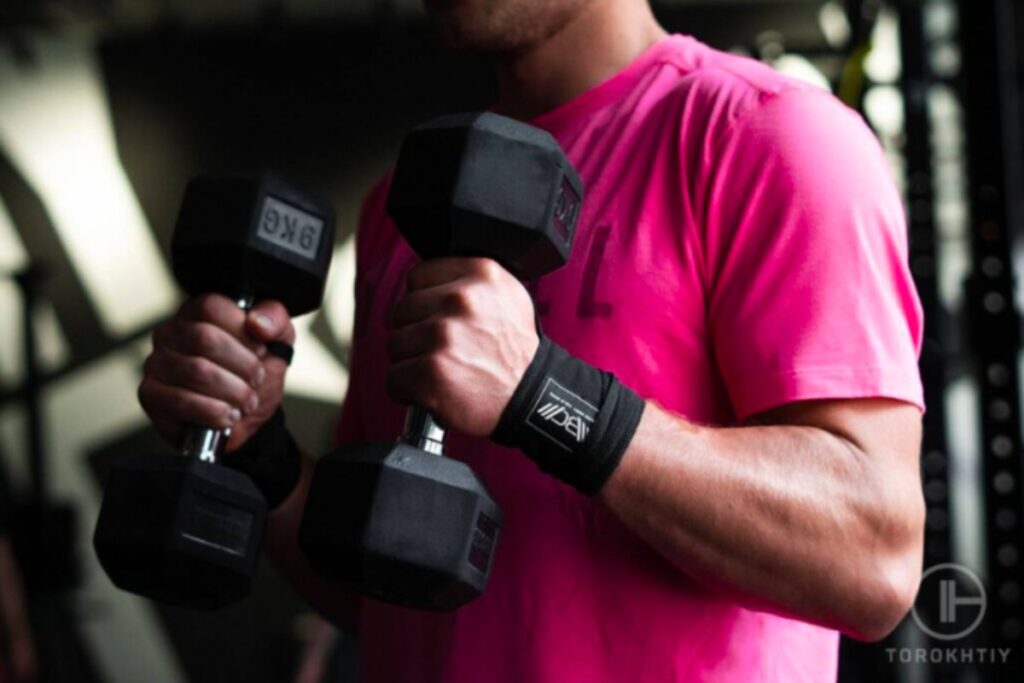
4. Change Your Bar Height
Along with grip width, the height of the bar can affect your wrist position and therefore cause wrist pain when squatting. While most lifters determine bar height based on performance, changing the bar height when experiencing wrist pain can provide a possible solution.
A lower bar position places more stress on your wrist joints compared to a higher bar position where your wrists tend to be in a more neutral position and bearing less load. One option could be doing more high bar squats in training, and only doing your low bar squats on heavy/competition specific training sessions.
This means you can still get stronger whilst experiencing less wrist pain and focusing more on technique and correct bracing or increasing your range of motion through wrist exercises.
5. Change the Barbell
If you’re lifting at a high-end facility, chances are you’ll have access to different types of barbells. A common barbell type that could provide a possible solution to your wrist pain issues is a safety squat bar.
Whilst a safety bar is mainly designed to take pressure off your shoulders, the grip position with your arms out in front of your body completely unloads your wrists too.
This allows you to perform squats normally while working on wrist mobilization and focusing on other possible causes. The safety bar provides an added challenge and it might be something you want to add to your program for good anyway.
FAQ
How Do I Stop My Wrist From Hurting on Low-Bar Squats?
Stopping your wrists from hurting during low bar squats involves a process of elimination to determine the underlying cause.
Start by changing your lifting position to see if that helps. Perform the wrist mobility exercises I’ve described above and use wrist wraps when lifting to provide convenient support to your wrist joints.
Is a Low Bar Squat Safer?
Whilst a low bar squat usually leads to better performance, it’s much harder to execute correctly for most lifters. Good shoulder and wrist mobility is needed to maintain a proper lifting position throughout the squat.
Conclusion
Low bar squat wrist pain is a commonly reported problem among lifters. Causes include an incorrect grip and barbell position and poor wrist mobility. By experimenting with your grip and bar position, performing wrist mobility exercises, and using wrist wraps whilst lifting, you’ll be lifting pain-free again in no time at all.
Have you experienced low bar squat wrist pain before? Have you tried to fix it? Let us know!
Also read:
- Best Wrist Wraps For Powerlifting
- Best Gym Wrist Wraps For Lifting
- Best Wrist Wraps
- Wrist Pain From Lifting
- Best Wrist Wraps For Calisthenics
- Rogue Wrist Wraps
- Safety Squat Bar Guide
- 6 Dumbbell Wrist Exercises for Strength and Stability
- 4 Front Squat Benefits That Will Make You Add It to Your Routine
- How To Get Bigger Wrists: Growth Strategies & Exercises
- Front Squat Grip Secrets – Techniques & Tips
References:
- Work on Wrist Mobility // ORTHOFIXAR: https://orthofixar.com/special-test/hand-wrist-movements/
- Work on Wrist Mobility // healthline: https://www.healthline.com/health/chronic-pain/wrist-and-hand-stretches#simple-stretches
- Use Wrist Wraps // bodybuilding: https://www.bodybuilding.com/content/how-why-and-when-to-use-wrist-straps.html
- Change the Barbell // garagegymlab: https://garagegymlab.com/5-safety-squat-bar-benefits/
- Photos made by Torokhtiy Media Team
Why Trust Us?
With over 20 years in Olympic weightlifting, strength training, nutrition coaching, and general fitness our team does its best to provide the audience with ultimate support and meet the needs and requirements of advanced athletes and professional lifters, as well as people who strive to open new opportunities and develop their physical capabilities with us.
By trusting the recommendations of our certified experts in coaching, nutrition, and sports training programming, as well as scientific consultants, and physiotherapists, we provide you with thorough, well-considered, and scientifically proven content. All the information given in the articles concerning workout programming, separate exercises, and athletic performance, in general, is based on verified data.
The product testing process is described in more detail here.
Author: David Sasha Schulz
Doctor of Chiropractic, BSc Human Biology, CSCS
Strength coach (CSCS) – 10 years
Sasha is a Chiropractor and Kinesiologist practicing in Kelowna, BC, Canada. He has been practicing Chiropractic since 2019, integrating manual therapy, strength training and programming principles, and nutritional strategies to get his patients optimal results. He currently scratches the competitive itch in fitness, and the occasional endurance race, and plays golf and snowboards for fun. He has an interest in all strength and fitness-related sports.
Reviewed by: Oleksiy Torokhtiy
Olympic Weightlifting Champion
Best Results: Snatch – 200 kg,
C&J – 240 kg
Oleksiy Torokhtiy is a professional athlete boasting 20 years of experience in Olympic weightlifting. With multiple European and World titles under his belt, he has showcased his prowess in two Olympic Games (Beijing 2008 and London 2012). Upon concluding his illustrious career, Oleksiy dedicated himself to coaching. By 2022, he had conducted over 200 weightlifting seminars worldwide. He is the visionary behind an international sportswear and accessories brand known for its motto, “Warm Body Cold Mind.” Additionally, he is an esteemed author and the creator of a series of training programs and eBooks.




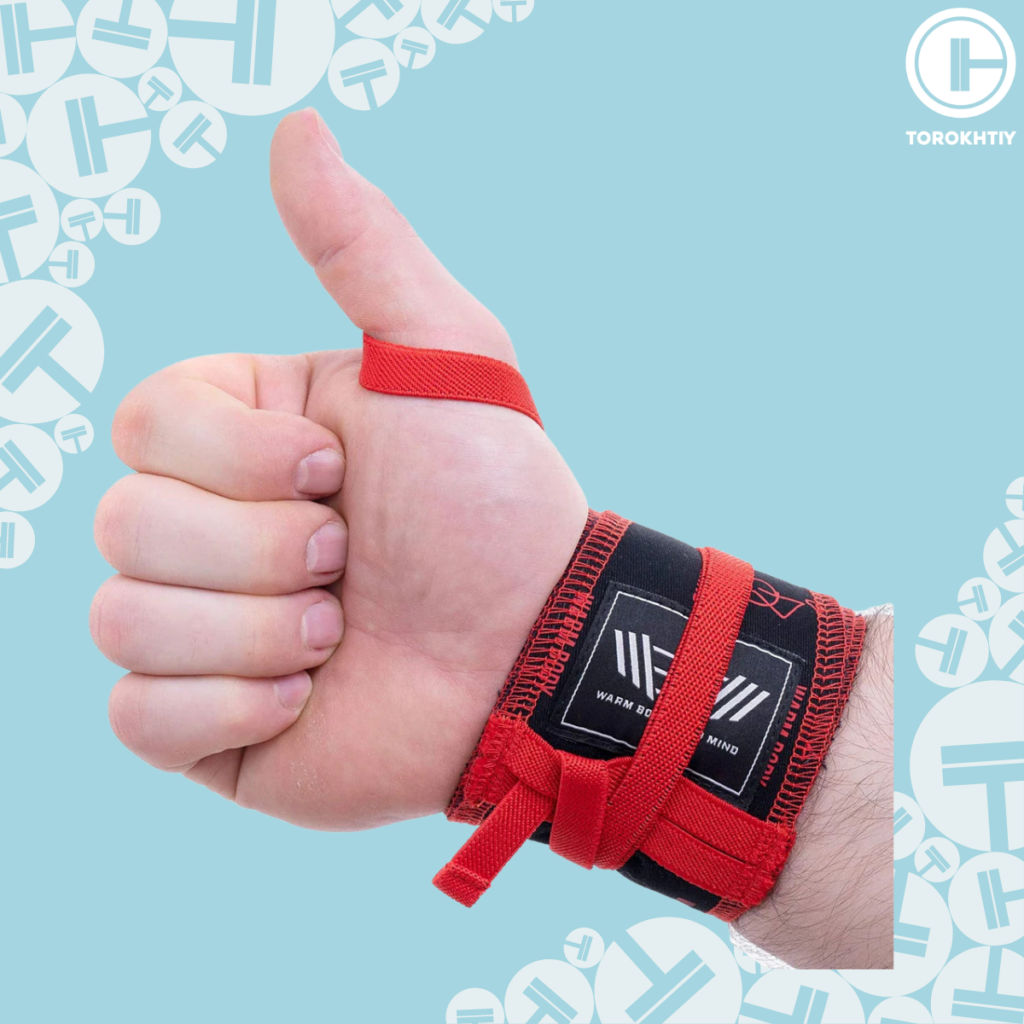
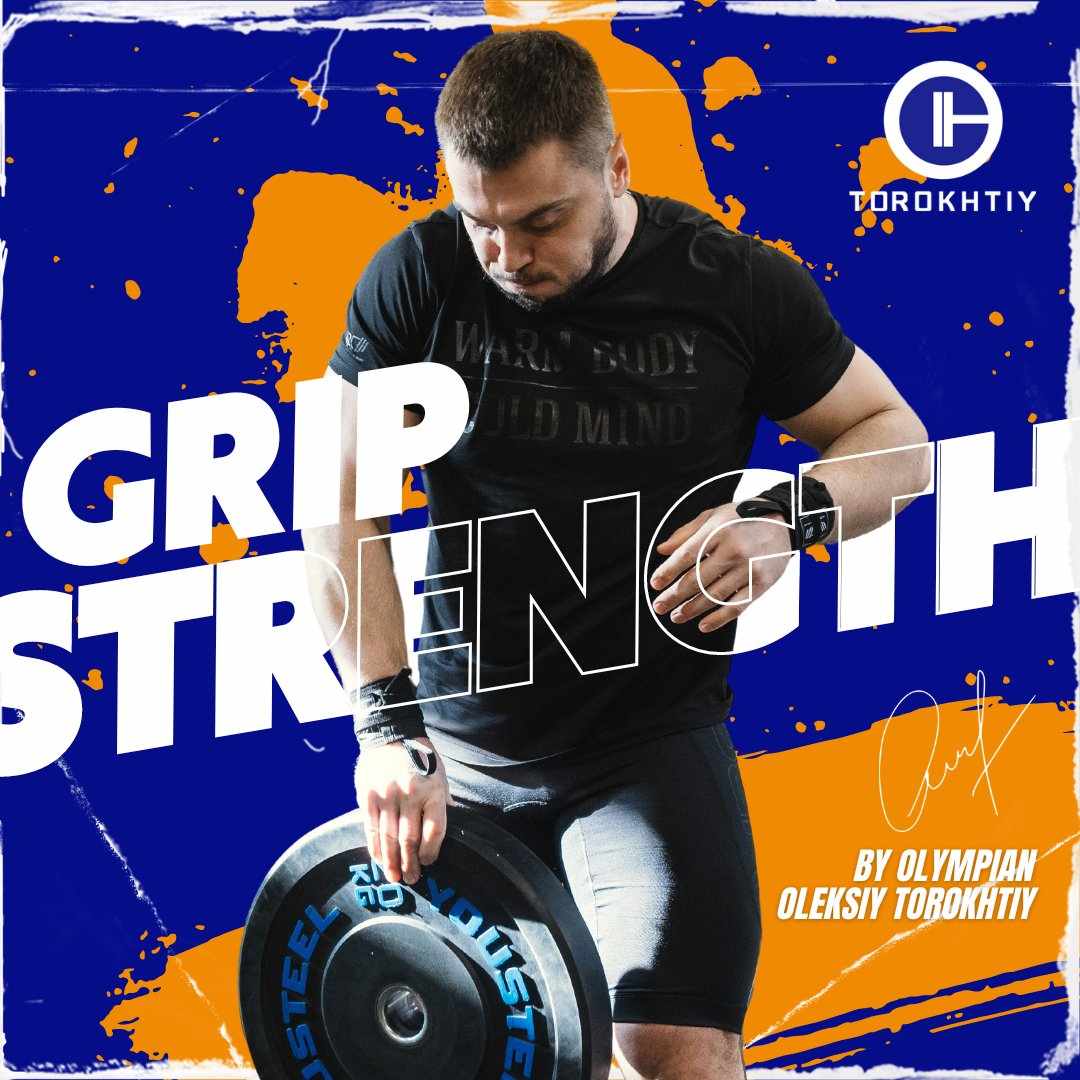
Still have questions after reading our article? Unlock your full potential by engaging with our experts and community! Don’t hesitate — leave a comment below and David Sasha Schulz will provide a personalized answer and insights to help you reach your goals.